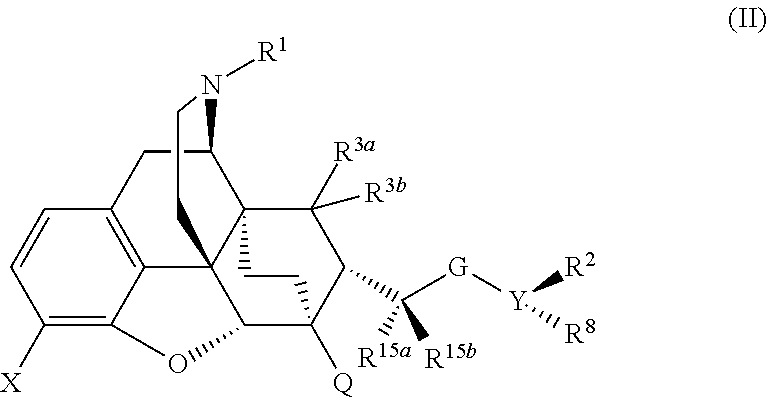Buprenorphine analogs
a technology of bupropion and analogs, applied in the field of bupropion, can solve the problems of not being able to assume that a drug is a drug, and being unable to be analgesic, and achieve the effects of treating, or preventing constipation, and reducing or preventing constipation
- Summary
- Abstract
- Description
- Claims
- Application Information
AI Technical Summary
Benefits of technology
Problems solved by technology
Method used
Image
Examples
example 1
(4R)-4-((4R,4aS,6R,7R,7aR,12bS)-3-(cyclopropylmethyl)-7,9-dimethoxy-1,2,3,4,5,6,7,7a-octahydro-4-a,7-ethano-4,12-methanobenzofuro[3,2-e]isoquinolin-6-yl)-4-phenylbutane-1,2,4-triol (Compound 6)
[0322]
[0323]Phenylmagnesium bromide (2.7 mL, 8.1 mmol, 3.0 M solution in ether) was added to a solution of 1 (2.2 g, 5.4 mmol) in THF (25 mL, anhydrous) at −10° C. under a nitrogen atmosphere. The resulting mixture was allowed to warm to room temperature overnight. The reaction mixture was quenched with ice water, extracted with ethyl acetate (EtOAc), dried over sodium sulfate (Na2SO4), filtered and concentrated. The crude 2 (2.8 g, quantitative yield, as a mixture of diastereomers) was used for the next reaction.
[0324]LC / MS, m / z=486 [M+H]+ (Calc: 485).
[0325]A mixture of 2 (2.8 g, 5.4 mmol) and 5% Palladium on carbon (5% Pd / C) in absolute ethanol (EtOH) (30 mL) was hydrogenated at 50 psi of hydrogen overnight. The mixture was filtered through a Celite pad and concentrated. The crude 3 (2.9 g, ...
example 2
2-(((S)-((4 R,4 aS,6 R,7 R,7 aR,12 bS)-3-(cyclopropylmethyl)-7,9-dimethoxy-1,2,3,4,5,6,7,7a-octahydro-4-a,7-ethano-4,12-methanobenzofuro[3,2-e]isoquinolin-6-yl)(phenyl)methyl)amino)acetic acid (Compound 12)
[0334]
[0335]Acrylonitrile (20 mL) was added to a solution of 2 (5.3 g, 15.0 mmol) in toluene (100 mL, anhydrous). The mixture was heated at 50° C. overnight. The reaction mixture was concentrated. Purification of the crude material by flash chromatography (SiO2,10-25% EtOAc / hexanes) yielded 8 (2.3 g, 37% yield) and 9 (1.92 g, 31% yield).
[0336]LC / MS, m / z=404 [M+H]+ (Calc: 403).
[0337]Phenylmagnesium bromide (1.15 mL, 3.4 mmol, 3.0 M solution in ether) was added to a solution of 8 (1.39 g, 3.4 mmol) in benzene (30 mL, anhydrous). The resulting mixture was heated to reflux overnight under a nitrogen atmosphere. A solution of ammonium acetate (5.9 g, 68.0 mmol) in methanol (20 mL) was added and the mixture was stirred at room temperature for 1 h. Sodium borohydride (1.2 g. 34.0 mmol) w...
example 3
2-(((S)-((4 R,4 aS,6 R,7 R,7 aR,12 bS)-3-(cyclopropylmethyl)-7,9-dimethoxy-1,2,3,4,5,6,7,7a-octahydro-4-a,7-ethano-4,12-methanobenzofuro[3,2-e]isoquinolin-6-yl)(phenyl)methyl)amino)propanamide (Compound 14)
[0351]
[0352]2-(7-Aza-1H-benzotriazole-1-yl)-1,1,3,3-tetramethyluronium hexafluorophosphate (HATU) (Sigma Aldrich) (86 mg, 0.23 mmol) was added to a solution of 13 (82 mg, 0.15 mmol) in THF (6.0 mL). After 10 min NH4Cl (32 mg, 0.6 mmol) and diisopropylethylamine (DIPEA) (131 μl, 0.75 mmol) was added. The resulting mixture was stirred overnight at room temperature. The reaction was quenched with water and extracted with CHCl3. The organic layer was dried over Na2SO4, filtered and concentrated. The crude material was purified by reverse phase chromatography (C18, acetonitrile / water with 0.1% TFA, 0-95%) to obtain Compound 14 (30 mg) as the di-TFA salt.
[0353]1H NMR (300 MHz, D2O) δ ppm: 9.34 (bs, 2H), 8.70 and 8.48 (2bs, 1H), 7.89-7.49 (m, 7H), 6.90 (d, J=8.3 Hz, 1H), 6.69 (d, J=8.2 H...
PUM
 Login to View More
Login to View More Abstract
Description
Claims
Application Information
 Login to View More
Login to View More - R&D
- Intellectual Property
- Life Sciences
- Materials
- Tech Scout
- Unparalleled Data Quality
- Higher Quality Content
- 60% Fewer Hallucinations
Browse by: Latest US Patents, China's latest patents, Technical Efficacy Thesaurus, Application Domain, Technology Topic, Popular Technical Reports.
© 2025 PatSnap. All rights reserved.Legal|Privacy policy|Modern Slavery Act Transparency Statement|Sitemap|About US| Contact US: help@patsnap.com



